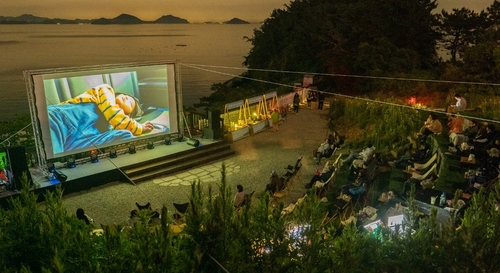It pairs outdoor film screenings with coastal trail walks and sunset viewing.
The stated goals are to expand local cultural life and give island residents better access to the arts.
However, balancing conservation with community burden is the festival's central challenge.
Films on an island: what does Chudo hope to achieve?
Overview
Culture is waking up.In September 2025, the second Chudo Island Film Festival will be held on Chudo, an island off Tongyeong in South Gyeongsang Province, South Korea (Tongyeong is a coastal city known for fishing and island tourism).
Programs center on outdoor film screenings, trail walks around the island, and sunset gatherings that use the landscape as a stage.
The organizers say the festival aims both to broaden cultural access for residents and to energize local tourism.
So the question is clear: how do you expand culture while protecting fragile nature?

History and context
The island moved to the center.The first Chudo festival introduced the event to the region and began to raise the island's profile.
It started from a common problem: islands often lag behind the mainland in cultural services.
Organizers intended to improve residents' cultural access while also attracting tourists.
Meanwhile, questions about long-term, sustainable management have surfaced: can a festival avoid being a short-term spike and instead become a steady asset?
"Island culture gains real value when visitors and residents shape it together."
Cultural significance
The mood shifts.Beyond screenings, the festival showcases how art and nature can combine.
Coastlines, woods, and narrow lanes become informal venues that give audiences unusual sensory experiences.
Additionally, programs such as poetry readings, conversations with local writers, and communal sunset meals featuring regional food turn cultural consumption into community life.
These elements help tie a sense of place to cultural practice.
Arguments in favor
Potential opens up.Supporters say the festival can become a real lever for local cultural revival.
First, access improves: island residents can enjoy films, talks, and performances without traveling to the city.
Second, tourism can create economic ripple effects—short-term demand for lodging, food, and transport can boost small businesses.
Third, the island's distinct landscape can become part of a cultural brand, offering a prototype for sustainable, place-based tourism.
For example, similar small-island cultural events have increased seasonal visitors and raised sales of local products.
In one case, a music festival on a small island helped secure public funds to upgrade basic infrastructure and increased revenue for guesthouses and restaurants run by locals.
Meanwhile, these events have sometimes strengthened community bonds by encouraging volunteer participation.
Overall, Chudo's film festival can be read as a policy experiment that aims to blend cultural value and economic benefit.
Arguments against
Concerns run deep.Critics warn of several real risks.
First, environmental damage: a small island can suffer if hundreds or thousands of visitors arrive at once—litter on beaches, disruption to wildlife, and erosion of trails are likely.
Second, resident burden: preparation and crowds can bring noise, traffic, and extra waste management costs that fall on locals.
Third, sustainability worries loom. Initial interest may fade while maintenance costs remain.
As a result, a festival can end up draining local resources.
Also, commercialization pressure is a threat: if organizers prioritize short-term profit, local character may be eroded.
Finally, financial transparency matters: unclear accounting for public funds and private sponsorships can undermine trust.
"An unsustainable festival eventually exhausts the community."
Past cases show that events run without deep resident consultation can create internal conflicts and even weaken grassroots cultural initiatives.
Therefore, from the design phase onward, resident participation, environmental impact assessment, and long-term financial planning are essential.
Balance and concerns
Balance is required.The festival's promise and its risks are not mutually exclusive.
Instead, they call for complementary measures.
First, on conservation: set visitor limits, enforce strict waste sorting, and designate protected ecological zones.
Second, governance: create a resident-led committee with real decision-making power over planning, revenue distribution, and local conveniences.
Third, finance: publish clear budgets for start-up and operating costs, and combine short-term sponsorship with committed, longer-term public or philanthropic support.
Furthermore, measure impact beyond attendance numbers—track whether jobs are sustainable and whether local goods and services develop new, lasting markets.

Finally, raise program quality.
Rather than a string of stand-alone events, integrate local artists into curatorial planning, add educational workshops, and design tourism products that respect daily life on the island.
These balanced steps are the most likely route to improving quality of life in the long run.
Practical proposals
Direction matters.To increase the festival's chance of success, consider the following.
First, conduct an environmental impact assessment before the event and set a clear visitor cap.
Second, form a legally recognized operating council that guarantees resident representation.
Third, reserve part of ticket and vendor revenue for infrastructure upgrades and habitat restoration.
Also, pair the festival with education: guided walks, local-heritage talks, and code-of-conduct briefings can help visitors learn to respect the place.
These measures reduce one-time visits and instead build positive memories that encourage return visits and longer-term tourism patterns.
Conclusion
The judgment is yours.The Chudo Island Film Festival presents a strong opportunity to showcase island values, but without careful planning it could produce negative side effects.
Goals to expand local culture and boost tourism are valid.
However, priority must be given to environmental protection and resident rights when putting plans into action.
With transparent finances, resident-led governance, and visitor management, the festival can move from a one-off event to a lasting local asset.
Key point: combining culture and nature is an opportunity—but without conservation and resident participation, it becomes a risk.
We ask the reader: if you visited Chudo, what rules or programs would you improve first?